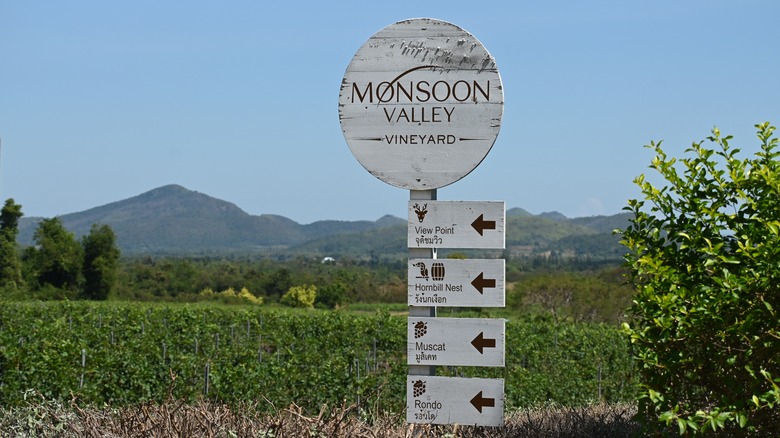The Thai Region Wine Lovers Should Keep An Eye On
A trip to Thailand often consists of soaking up the sun at stunning beaches, visiting ancient Buddhist temples, and uncovering the marvels of the bustling nightlife. Part of the experience is also dining like a local, tasting the country's iconic curries, noodles, and soups. But, that's not all. Wine lovers will be pleased to know that lately, parts of Thailand have been dubbed a haven for oenophiles. There's one Thai region in particular that wine enthusiasts should definitely add to their bucket list. Can you guess where it is?
Wine tourism is a great way to learn about a new place and its culture. Uncovering history, traditions, and brand-new flavors, both the novice and the sommelier can recognize the appeal of exploring even a relatively unknown (and untraditional) wine region like Thailand. Growing varietals like Shiraz, Tempranillo, Black Muscat, Chenin Blanc, Colombard, Malaga Blanc, and the local, dark-skinned Pok Dum grape, Wine Cooler Direct explains that far from terroir-focused Old World wines and ostentatious New World wines, Thai winemakers are actually pioneering New Latitude wines.
A term reserved for places previously deemed unviable due to climate — areas falling between 30 degrees North and 30 degrees South of the equator — Jancis Robinson explains that New Latitude Wines are now possible as a result of advancements in viticulture, coupled with the ability to better manage vine growth. Of the few Thai wineries, one tropical zone, in particular, begs to be explored by grape juice fans.
A wine lover's paradise
Not far from Bangkok, the valleys near coastal Hua Hin are home to vineyards like the acclaimed Monsoon Valley Vineyards (formerly Hua Hin Hills Vineyard). Built on a former elephant corral, the winery is known for its stunning selection of white, red, rosé, and sparkling wines made from both international and local varietals. Part of the Siam Winery label, Monsoon Valley is a shining example of the burgeoning greatness of Thai wines.
Benefitting from cooling sea breezes and fossil-enriched loam soils, the Wine International Association explains that most wines produced in Hua Hin display a crisp, vibrant minerality. However, winemaking techniques such as aging wine "sur lie" or in oak barrels can also add complexity to vintages, notes Thrillist, illustrating that Thai wines can vary in acidity, dryness, and depth — they're no longer made in strictly sweet and fruity styles that balance spicy food, they're also suitable for solo sipping.
Predominantly featured on domestic wine lists in high-end establishments, Wine Searcher reports that bottles have been increasingly exported within the global Thai restaurant sector. But, if you'd rather drink a Hua Hin-produced wine straight from the source, then Wine Enthusiast recommends forgoing the monsoon season in favor of a visit during November or December. Should you be looking for more tasting opportunities, The Culture Trip also recommends visiting regions like Khao Yai or Pattaya — you can even visit Samut Sakhon to catch a glimpse of the incredible "floating" vines!

